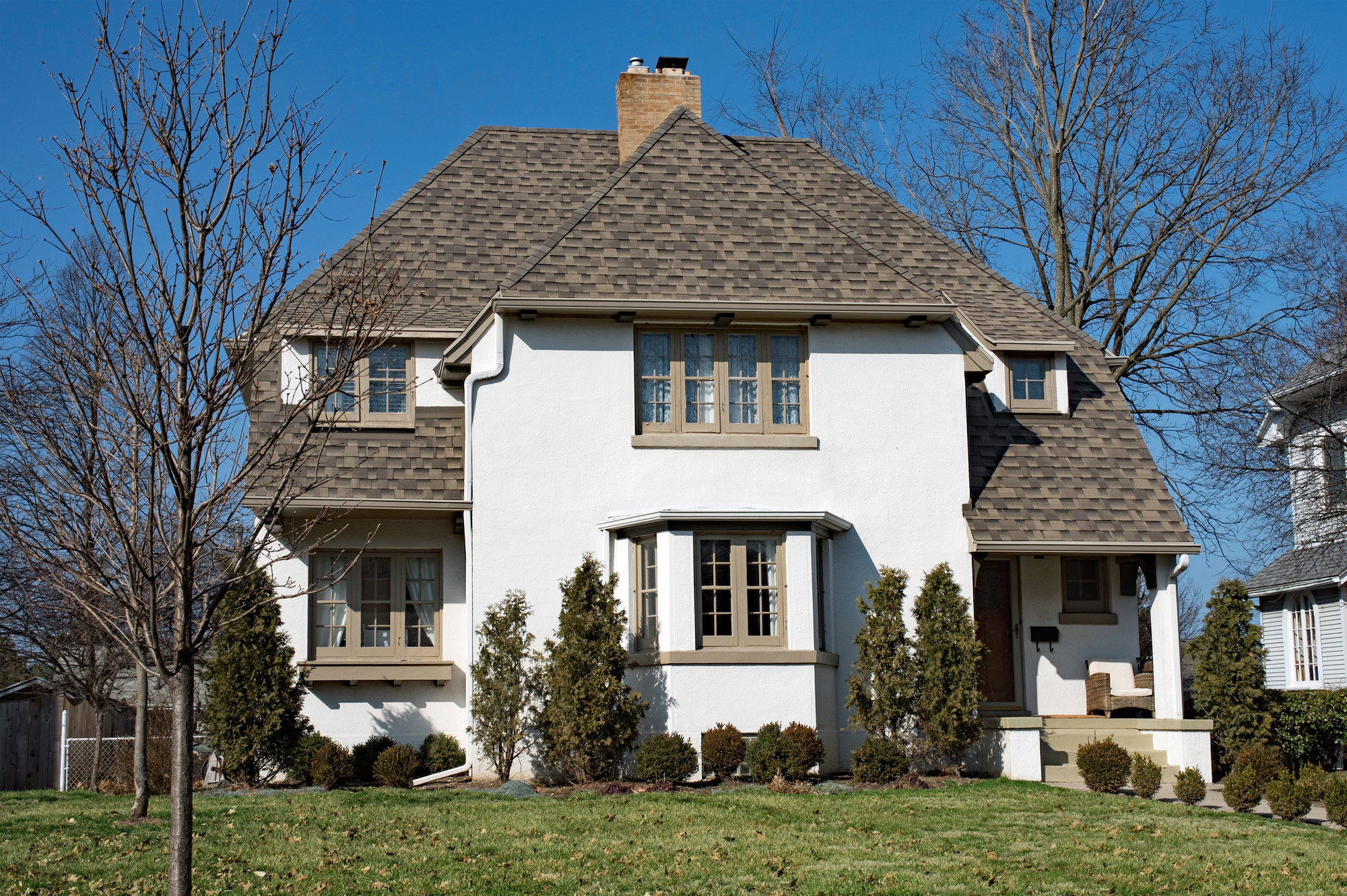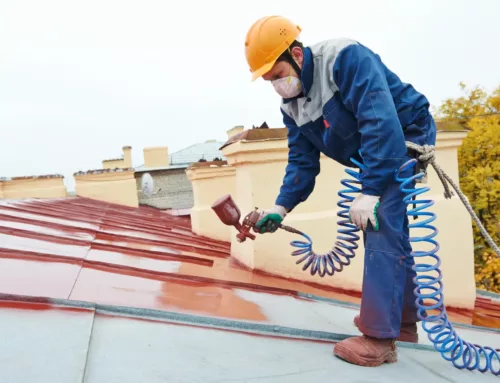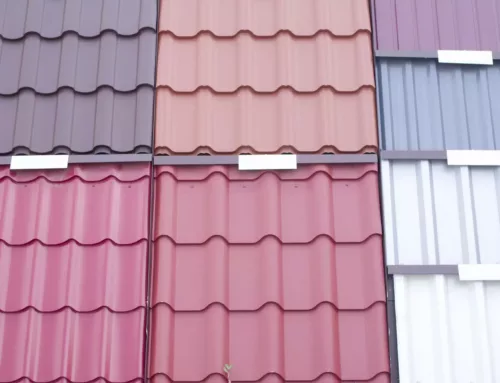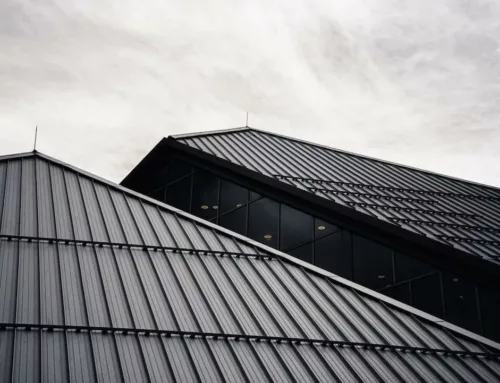Ever stared at a charming house and found yourself entranced by its unique roof, asking what is a hip roof? You’re not alone.
Picture this. A quiet suburban neighborhood with manicured lawns, tree-lined streets, and homes boasting symmetrical roofs sloping on all sides like gentle waves meeting at the crest. That’s the classic beauty of hip roofs!
We often take them for granted, but these architectural wonders have more to offer than meets the eye – from resilience against strong winds to offering ample living space. They are akin to unsung heroes in home design that protect us while adding an aesthetic charm.
Got your attention? Great! Let’s dive right in and uncover all there is to know about hip roofs. We’ll explore their types, see how they stack up against gable roofs, and understand the impact of geographical factors on their use.
Table Of Contents:
- Understanding the Basics of Hip Roofs
- Types of Hip Roofs You Should Know
- Comparing Hip Roofs with Gable Roofs
- Geographic Influence on Hip Roofs
- The Art of Designing and Building a Hip Roof
- The Role of Pyramid Roofing in Kansas City’s Hip Roofs
- Understanding Potential Challenges with Hip Roofs
- FAQs in Relation to What is a Hip Roof
- Conclusion
Understanding the Basics of Hip Roofs
If you’ve ever seen a roof with all four sides sloping downwards to meet at a single point, you’ve spotted a hip roof. This distinctive layout is not just visually appealing; it’s also valued for its ease and resilience.

Residential Home with a Hip Roof
A study on wind performance revealed that hip roofs stand up remarkably well against strong winds. That’s why they’re often found on church steeples and suburban houses, where strength matters most.
Hip Roof Design: It’s All About The Slopes
The magic in a hip roof lies in its slopes. Each side descends from the peak, creating no flat ends or gables – only smooth angles meeting at one spot. But don’t be fooled by their seamless look; these roofs require careful planning and precise measurements during construction.
In essence, imagine an umbrella without any bends – this gives you some idea of what makes up the design of a hip roof. Simple yet effective protection from Mother Nature’s elements.
The Many Faces of Hip Roofs
There are various types within this category too – each offering something different depending on your needs and aesthetic preferences. From standard forms to intricate pyramid structures or even combinations incorporating gable features – there truly is a style for everyone when it comes to ‘hip’ roofing.
Hip Roof Advantages And Disadvantages: A Balanced Perspective
We can’t talk about what defines these rooves without considering both sides – advantages as well as disadvantages come into play here too. One significant advantage is stability under challenging weather conditions like wind or snow. However, there are some drawbacks to consider.
For one, they’re more expensive to build than a simple gable roof due to the complexity of their design. Secondly, these roofs can be prone to leaks if not constructed properly – another factor adding cost implications when considering hip roofs for your home or building project.
Key Takeaway:
A hip roof, with its all-around slopes meeting at a single point, is both simple and durable. This design stands strong against tough weather but demands careful planning and precision in construction. Although more costly than a gable roof and potentially leak-prone if not well-made, it offers varied styles for different aesthetic preferences.
Types of Hip Roofs You Should Know
If you’re thinking about roof designs, a hip roof might be the perfect fit. This popular design features all four sides sloping down from the peak with no flat ends or gables. But did you know there are various types to consider? Let’s explore some of them.
The Pyramid Hip Roof
A pyramid hip roof, as its name suggests, forms a pyramid shape at the top. Each side is triangular and meets at a single point on top, making it an ideal choice for smaller buildings like bungalows or gazebos where uniformity and simplicity enhance aesthetics.
This style doesn’t just look good though – its symmetry also gives it great stability against strong winds. However, this type does limit usable attic space due to its steep slopes.
The Cross Gable Hip Roof
Moving on to another variety: The cross gable hip roof. It’s similar in design to your standard hip roof but comes with two perpendicular wings that add more interior space – think larger rooms and extra storage. This style provides better ventilation too which can help reduce heating costs during summer months.
The complexity involved in building these roofs may raise initial construction costs slightly compared with other styles but don’t let that deter you; their unique appearance could increase property value over time.
Other variations worth mentioning include:
- Dutch gable: A blend of both hipped and gabled designs resulting in enhanced aesthetic appeal along with additional functional attic space.
- Jerkinhead: Also known as a clipped-gable or half-hipped roof, reduces wind damage risks while still offering attractive looks.
- Combination: As the name suggests, it’s a combination of different styles to suit unique building shapes and designs.
To sum up, hip roofs are not just about functionality. They offer aesthetic variety too. Each type has its own charm and purpose. Your choice will depend on your needs – whether you prioritize durability against harsh weather conditions or desire additional living space.
Key Takeaway:
Hip roofs pack a punch beyond what you see at first glance. They come in all shapes and sizes, from snug pyramid styles to roomy cross-gable designs, not forgetting unique blends like Dutch gables or Jerkinheads – each with its own appeal. So if it’s weather-proofing or extra space you’re after, rest assured there’s a hip roof style out there just for you.
Comparing Hip Roofs with Gable Roofs
Each has its own advantages and disadvantages.
A gable roof, for instance, is less expensive to build compared to a hip roof. This style’s straightforward design makes it cost-effective but doesn’t offer the same wind resistance as its counterpart.
Gable vs. Hip Roof: Advantages & Disadvantages
When it comes to advantages and disadvantages, both styles have their share. A key benefit of gable roofs is their simple construction process which allows them quick completion times and lower costs.
Hip roofs are more complex in terms of construction but boast excellent performance against high winds due to their sloping sides on all four walls – making them ideal for hurricane-prone areas.
Snow Performance
In regions that see heavy snowfall each year like Kansas City, hip roofs show off one more advantage – they distribute weight evenly across all sides resulting in less chance for damage from accumulated snow load.
Gables may struggle here because the two-sided structure tends to accumulate snow at higher rates leading potentially to structural issues down the line if not properly maintained during winter months.
Wind Resistance
A study conducted by ScienceDaily found that these types can better withstand high-speed winds compared with gables because there are no flat ends facing directly into wind flow allowing breezes to easily pass around them.
Roof Slope Considerations
The slope is a critical aspect to consider when choosing between hip and gable roofs. For instance, steep slopes on a gable roof can lead to increased attic space, which could be converted into a living area or used for storage.
While hip roofs might not be as steep, they make up for it with better stability. They’re really good at standing up to wind and snow.
Key Takeaway:
Can’t choose between a hip and a gable roof? Let’s break it down. Gable roofs are cheaper and easier to build, but wind can be their downfall. On the flip side, hip roofs might be trickier to put together, but they’re champs against high winds – perfect if hurricanes often visit your area. Plus, they handle heavy snow like pros by evenly spreading the weight.
Geographic Influence on Hip Roofs
The geographical location you inhabit can often determine the type of roofing system best suited for your home, particularly in regard to hip roofs. This is especially true for hip roofs, a style that’s well-loved from the East Coast of Canada to Kansas City.
Hip roofs are known for their superior wind performance, making them an ideal choice in high-wind areas. But why does this matter? Imagine your home being smack-dab in the middle of Hurricane Alley. You’d want to take all the steps you could to shield it, right?
Studies show that due to their aerodynamic design, hip roofs have a better ability than other styles like gable or flat roofs to deflect strong winds without sustaining major damage. It’s like comparing a sleek sports car with a boxy van when driving against heavy winds – guess who wins?
Hip Roofs on the East Coast of Canada
In places such as Nova Scotia and New Brunswick where fierce storms frequently batter coastlines, homeowners prefer hip roofs because they provide greater stability and resilience against extreme weather conditions.
Hip Roofs in Kansas City
Moving over 1,600 miles southwest towards Kansas City – another region where tornadoes aren’t exactly rare guests – we see again how geographical location influences roofing choices. Here too people favor the robustness and dependability offered by hip roof structures.
Bonus: Insurance Discounts.
Do you know what else rocks about having these resilient beauties atop your homes? In some regions prone to tornados (I’m looking at you Kansas), insurance companies offer discounts if your house sports a hip roof. How cool is that?
So, next time you’re thinking about what kind of roof to install or recommend, remember the influence geography can have. A hip roof might not only save your house, but it could also help save some hard-earned cash.
Key Takeaway:
Opting for a hip roof isn’t merely a style choice, it’s also a wise one. Their aerodynamic design excels at warding off strong winds – ideal for places with severe weather such as Canada’s East Coast or Kansas City. Plus, you might even bag an insurance discount in some areas. So, not only does a hip roof look good, but it also offers solid protection.
The Art of Designing and Building a Hip Roof
Creating a hip roof is like crafting an origami masterpiece. It requires precision, patience, and careful consideration.
Selecting the right materials can be as critical as picking the perfect shade of paint for your living room walls. Aesthetic considerations aside, you need to ensure that the material chosen is durable enough to withstand a variety of weather conditions.
Selecting Materials
Different roofing materials are suitable for hip roofs. For instance, asphalt shingles are affordable and easy to install but may not last as long in extreme climates compared with metal or tile roofing.
Metal roofing has excellent durability but might make your home feel like a spaceship if not installed properly. Meanwhile, tile roofing adds charm and character while offering superior longevity – kind of like having George Clooney at your dinner party.
Determining the Right Slope
The slope defines how steeply pitched your roof is going to be. This isn’t some arbitrary number pulled out from thin air; it depends on factors such as local climate patterns (how much snowfall?), architectural style (does modern minimalist ring any bells?), and personal preference (do you want mountain peaks or gently rolling hills?).
To choose correctly involves calculating the roof area for a hip roof using simple geometry: think back to those Pythagorean Theorem days.
To aid this process there’s diagonal bracing for hip roofs – sort of like Batman’s utility belt keeping everything upright & sturdy.
Remember building forts out of cushions when we were kids? We needed different-sized pillows depending on how big we wanted our fortress to be. In a similar vein, the size of your hip roof will influence the type and quantity of materials needed.
So, are you all set to swap your superhero cape for a contractor hat and construct the ideal hip roof? Let’s check everything off our list first: from selecting top-notch materials like an artist picking out paints to figuring out just how steep
Key Takeaway:
Crafting a hip roof is like creating a masterpiece. It’s not just about aesthetics, but also about picking sturdy materials that can withstand all sorts of weather. The angle isn’t random – it reflects local weather patterns, architectural trends, and your own taste. Figuring out the area with basic geometry lets you choose the right amount of materials.
The Role of Pyramid Roofing in Kansas City’s Hip Roofs
Pyramid Roofing has a reputation for delivering top-notch roofing solutions, and their expertise with hip roofs is no exception. This well-regarded contractor uses quality roofing materials to ensure long-lasting results.
Kansas City homeowners trust Pyramid Roofing because they know the value of good service. From initial consultations through project completion, customers can count on receiving excellent service that exceeds expectations.
This commitment to customer satisfaction isn’t just talk – it’s ingrained in every job done by this stellar team. For instance, when installing a hip roof, which requires precise craftsmanship due to its unique design, they go above and beyond to deliver perfection.
A great example lies in how meticulously they choose materials for each project. Quality matters at Pyramid Roofing; hence only high-grade supplies make the cut. They use sturdy shingles designed specifically for hip roofs’ intricate angles – ensuring your roof not only looks amazing but also withstands whatever Mother Nature throws its way.
Beyond material selection, the Pyramid’s workmanship shines during installation too. Their skilled tradesmen have years of experience working with complex designs like those seen on many Kansas City homes’ hip roofs.
All these details matter because proper execution means your home stays dry while looking fantastic. Getting it done correctly from the start not only ensures a good result but also saves you time and money in the future.
But Pyramid Roofing’s commitment doesn’t end when the job is done. They stand behind their work, offering excellent post-installation service to keep your roof looking and performing its best for years to come.
So, you’re a homeowner in Kansas City and need a pro at hip roofs? Your search ends with Pyramid.
Key Takeaway:
When it comes to top-quality hip roofs in Kansas City, Pyramid Roofing is the name you can trust. Their use of first-rate materials and keen attention to detail results in durable and visually appealing roofs. Each project showcases its precision – be it perfect cuts around chimneys or skylights, ensuring proper drainage through careful alignment, or applying meticulous flashing that stands strong even against harsh weather conditions.
Understanding Potential Challenges with Hip Roofs
Hip roofs, despite their beauty and durability, do have a few potential drawbacks. First off is the cost of building a hip roof. It’s no secret that these types of roofs can be more expensive due to their complex design.
The extra materials needed for construction combined with the labor-intensive process result in higher costs compared to other roofing styles. While this may deter some homeowners, others view it as an investment toward long-term structural integrity and aesthetic appeal.
Another concern when considering a hip roof is the risk of leaks. The very design that gives them their strength – slopes on all four sides meeting at one point – also makes them susceptible to water intrusion if not properly sealed or maintained.
Rainwater has a tendency to accumulate where the slopes meet, leading to potential leakage points over time unless they’re regularly checked and repaired by professionals like those from Pyramid Roofing.
Maintaining Your Hip Roof
Maintenance becomes crucial when dealing with these issues associated with hip roofs. Regular inspections are necessary so any damage can be spotted early before it worsens into something costly like mold growth or wood rotting inside your attic space.
If you’re a hands-on type who likes DIY projects around your home then regular maintenance shouldn’t pose too much trouble; but remember – safety first. Always use proper equipment while doing any kind of repair work on high surfaces such as your roof.
The Cost-Benefit Analysis
Despite these challenges though there are still many reasons why homeowners choose hip roofs for their homes including added living space inside (thanks to those steep inclines), better resistance against winds especially during tornado season, and a timeless, classic look that enhances the overall curb appeal of your home.
So, hip roofs might be a bit tricky and pricey, but they’ve got perks that make them worth a look. If you’re figuring out the best roof for your place,
Key Takeaway:
While hip roofs might come with a higher price tag and potential leak risks due to their intricate design, they make up for them in durability, aesthetic appeal, and wind resistance. Regular maintenance can mitigate these challenges. Weighing the pros against the cons shows that if you’re after longevity and curb appeal, a hip roof could be your top pick.
FAQs in Relation to What is a Hip Roof
What are the disadvantages of a hip roof?
Hip roofs can be pricier to build than gable roofs. They’re also more likely to leak because they have more seams.
What is the purpose of a hip roof?
The design of a hip roof allows for better wind resistance and durability, especially in high-wind areas or storm-prone regions.
What is the difference between a gable and a hip roof?
Gable roofs have two sloping sides that meet at an apex, while all four sides slope downwards from the peak on hip roofs. Gables cost less but hips withstand wind better.
Is a hip roof more expensive?
Yes, building a hip roof generally costs more due to its complex structure which requires additional materials and labor.
Conclusion
We’ve arrived at the conclusion of our adventure! And what a ride it’s been! By now you should have a pretty solid answer to your question – what is a hip roof?
We delved into the types of hip roofs and their unique features. We saw how they offer resilience against strong winds and create additional living space.
We also compared them with gable roofs, taking note of pros like wind resistance and cons such as cost implications.
The impact geography has on roofing choices was an eye-opener too!
Remember that building a hip roof might be more expensive but can save money in hurricane-prone areas through insurance discounts.
In conclusion, keep these insights handy when planning your next home design or renovation project. The humble yet sturdy hip roof could just be your perfect choice!







